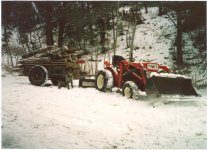jonathco
Silver Member
- Joined
- Jul 7, 2012
- Messages
- 230
- Location
- Byron, MI
- Tractor
- 1957 Ford 950, 1942 Farmall A w/ loader, John Deere 110, Sears ST16, John Deere 750, Case 3012
Howdy Folks,
I've got a MFWD JD 750 with with turf tires and I need more traction. From other posts I've read, I understand I would need to secure a set of Ag rims in order to run Ag tires, but I am curious if anyone knows a more aggressive turf tire I could run? My 750 is my only "big" tractor right now on the hobby farm, and thus, does everything from pulling the finish mower, brush hogging, pulling a 1 bottom plow and disking about an acre of garden plot.
Anyone have some recommendations on a good aggressive turf tire that might improve traction a bit?
Cheers,
Jon
I've got a MFWD JD 750 with with turf tires and I need more traction. From other posts I've read, I understand I would need to secure a set of Ag rims in order to run Ag tires, but I am curious if anyone knows a more aggressive turf tire I could run? My 750 is my only "big" tractor right now on the hobby farm, and thus, does everything from pulling the finish mower, brush hogging, pulling a 1 bottom plow and disking about an acre of garden plot.
Anyone have some recommendations on a good aggressive turf tire that might improve traction a bit?
Cheers,
Jon

